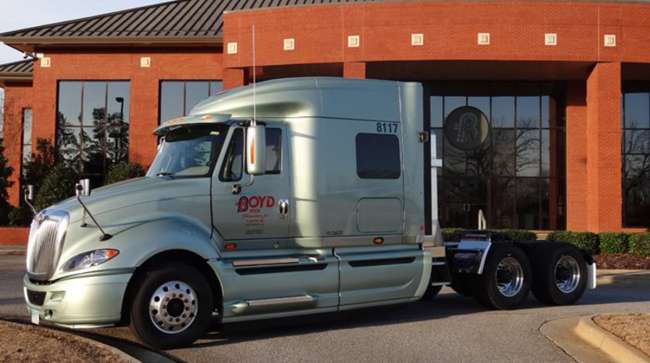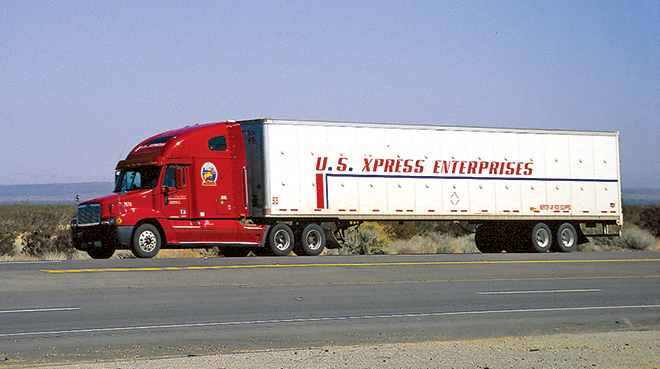Carriers Try Creative Compensation Programs to Bring in New Drivers

The driver shortage appears to be getting worse, with fleets launching new and enhanced compensation programs. These include Boyd Bros. trying a weekly salary, a sizzling $50,000 team bonus program from U.S. Xpress Enterprises, and a host of other deals to recruit and retain qualified drivers.
The salary idea from Clayton, Ala.-based Boyd Bros. seems normal, but it’s an oddity for truck drivers used to pay-per-mile compensation.
Boyd’s Mission Fleet program offers its flatbed drivers $1,300 a week, or $67,600 annually, and a guaranteed 48 hours of home time each week between Friday and Sunday. Drivers also accumulate sick and vacation days on a regular basis, not after a year of work.
Recruits are looking for a new kind of driving job, said Lori Furnell, vice president of communications.
“It’s time to redefine Over-The-Road irregular route trucking. It’s harder to find drivers willing to make these kind of sacrifices — away for a time, unpredictable schedules,” Furnell said. “And we want to attract high-quality drivers. We’re looking for someone that brings stability, safety and experience.”
Boyd, a Daseke company, is seeking to bring 30 new drivers on board, she said.
Drivers ask for more predictability, said Furnell, a foreign concept to flatbed drivers who can be away from home for weeks as they crisscross the country.
Boyd requires that the Mission Fleet drivers live within a triangle encompassing Nashville, Tenn., Bowling Green, Ky., Birmingham, Ala., Atlanta, and Charlotte, N.C. to ensure that they get their 48 hours off on weekends, said Furnell.
Boyd isn’t alone in needing more drivers. American Trucking Associations last year reported the shortage at more than 50,000 drivers. Research firm FTR said the number is closer to 250,000 drivers when firms such as UPS Inc., and oil field service outfits are included.
The problem is impacting company results. YRC Worldwide disclosed extra expenses in the fourth quarter of $7.1 million due to short-term rentals and the driver shortage, and Knight-Swift Transportation Holdings reported “the challenging driver market remains the biggest headwind faced by (our) Swift Truckload (division).”

TT File Photo
Driving teams are becoming more valuable as carriers adapt to one- and two-day delivery requirements brought about by e-commerce. Chattanooga, Tenn.-based U.S. Xpress announced its TeamMAX Bonus offering current and future team drivers the potential to earn bonuses up to $50,000 (per team), along with four weeks paid vacation a year.
TeamMAX members can earn up to 82 cents per mile, get first dibs on new trucks and receive top priority at service centers.
U.S. Xpress has more than 7,000 drivers and generates about 15% of revenues from its teams, President Eric Fuller told Transport Topics.
U.S. Xpress also is seeing more demand because some carriers did not meet the electronic logging device mandate in December, Fuller said.
“That freight is coming back into the market. Those ‘tweener’ loads, 500 to 750 miles, are not perfect for teams but we can match them up and get them out,” said Fuller.
U.S. Xpress ranks No. 21 on Transport Topics’ list of the 100 largest for-hire carriers in North America.
Green Bay, Wis.-based Schneider also seeks more teams with a sign-on bonus of up to $30,000 per team. There are opportunities in its van truckload, tanker, dedicated and less-than-truckload segments, and a driver gets the newest equipment in the fleet, Schneider promises. Schneider ranks No. 6 on the for-hire TT100.
A smaller firm taking a creative approach to compensation is Roberts Trucking, a hauler of construction aggregate and dirt in 29 company-owned trucks in the Dallas-Ft. Worth metro area.

Roberts by Joe Terry/Transport Topics
President Quincy Roberts said the firm gives its employee drivers a choice of being paid an hourly rate or a commission based on the number of loads they carry.
“We wait until the end of the week and determine which approach pays them best,” said Roberts. “Usually it’s the commission. It makes them more efficient and drivers like it.”
The high demand for qualified drivers should continue through 2018, according to FTR Vice President Avery Vise. There will be plenty of freight and capacity is already maxed-out.
The industry will make operations work more efficiently and carriers will add more trucks to their fleets, said Vise. Those efforts, in a sense, mean ‘more’ drivers and the shortage may decline by the third quarter, said Vise.
But don’t relax. FTR still expects a shortage of 200,000 drivers at year’s end.




